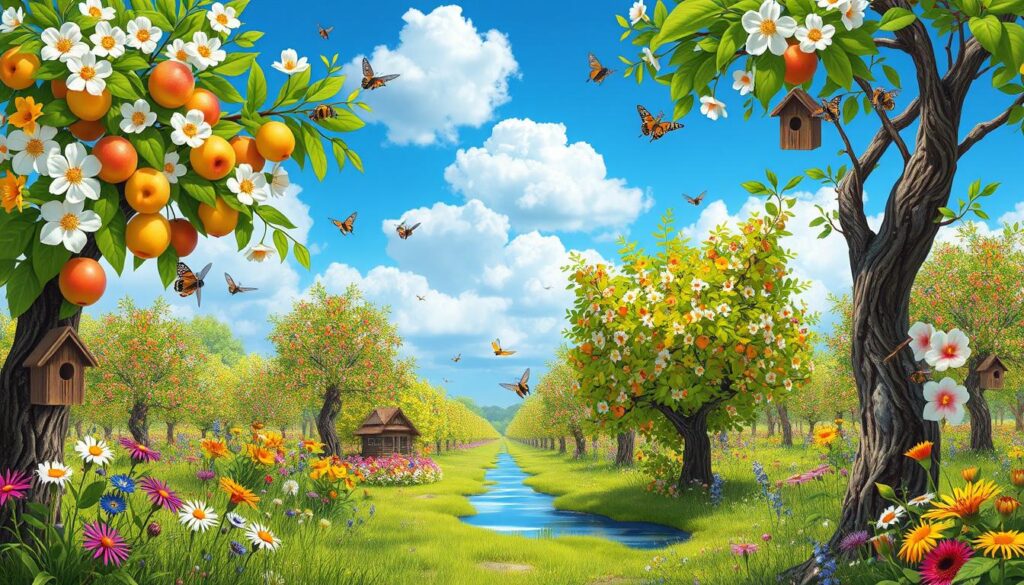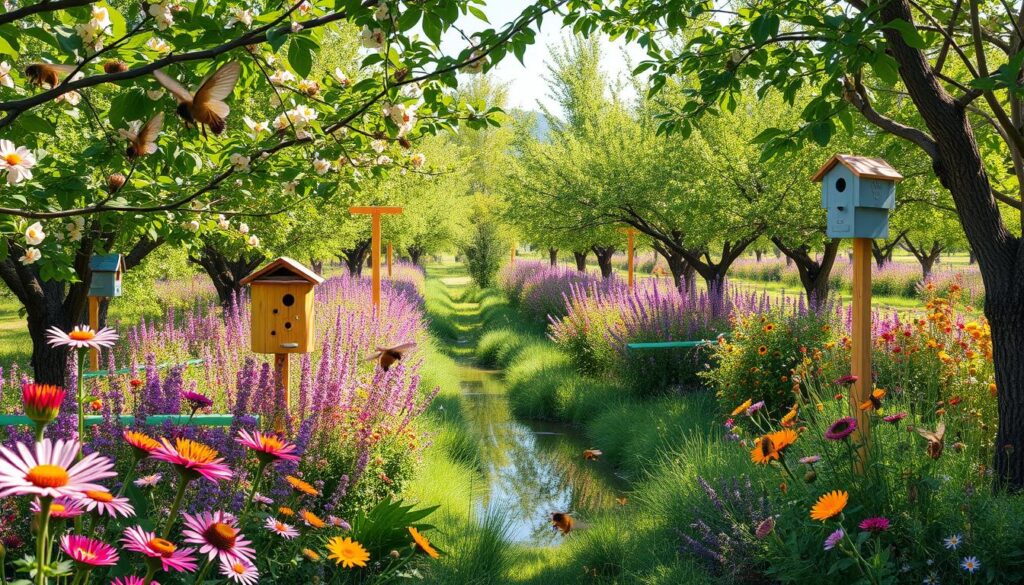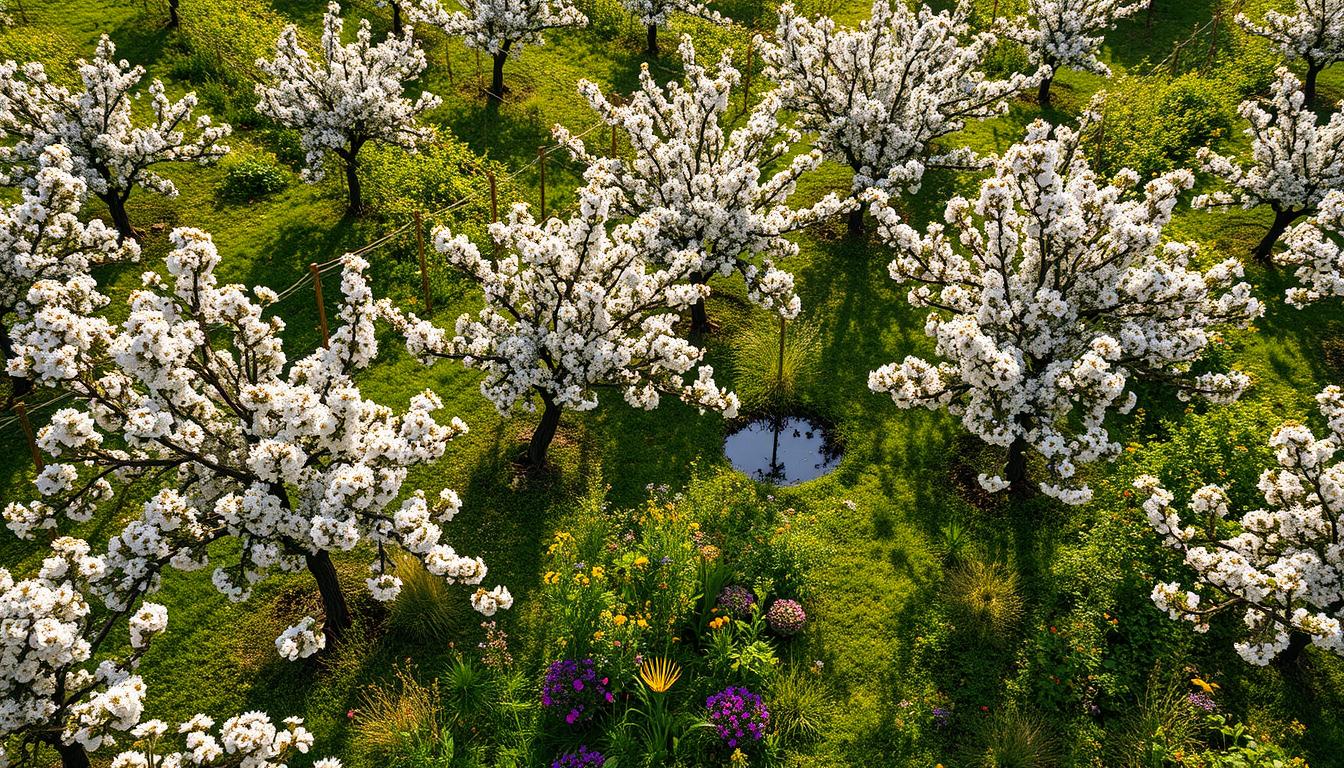Creating a pollinator-friendly orchard boosts both the environment and the farm’s economy. It helps improve crop yields and biodiversity. Pollinators, like bees, are key to orchard success, especially for fruits like apples and cherries. For instance, sweet cherries need at least 80% of flowers to pollinate for the best yields.
This guide aims to share the perks of pollinator-friendly practices. It will also cover how to design orchards effectively. We’ll look at how to check if an orchard pollinates well and what each fruit variety needs. By using these strategies, we can create a space that supports bees and other pollinators, essential for fruit growth.
For more tips on gardening for pollinators, check out GardenBeginner.com. This site offers detailed guides and resources to help grow a healthy ecosystem.
Key Takeaways
- Pollinator-friendly orchards increase crop yields and biodiversity.
- Up to 80% of flowers on sweet cherries must be pollinated for maximum yields.
- Managed honey bees and wild bees have different effectiveness in pollination.
- Integrating diverse plant species can attract a wide variety of pollinators.
- Nesting habitats are crucial for maintaining healthy bee populations.
- Monitoring pollinator activity can provide insights into orchard health.
Understanding the Importance of Pollinators
Pollinators are key to keeping farms productive and diverse. They help orchards grow more fruit, both in amount and quality. Studies show that pollinators boost yields for crops like watermelon and almonds in California. In Michigan, blueberry farmers see better results with native pollinators around.
The Role of Pollinators in Orchard Productivity
Pollinators are vital; they pollinate over 75% of flowering plants. This means one-third of our food depends on them. Healthy pollinators mean better crops. For example, tart cherries need 80% pollination to be worth selling.
Having native and honey bees in orchards can lead to better yields. This is because they help pollinate more efficiently.
Native Bees vs. Honey Bees
The debate between native and honey bees is important for better pollination. Native bees are a big help in California, with over 1,600 species. They are more efficient than honey bees, especially in cooler weather.
Knowing the strengths of both types of bees helps farmers improve their orchards. Planting native flowers and using gentle pest control can make a big difference. This creates a better environment for all bees.
How to Create a Pollinator-Friendly Orchard
To make an orchard friendly to pollinators, you need a good plan. First, understand how pollination works in your orchard. This means figuring out which fruits need help from other plants to pollinate and which can do it alone.
For example, apples and sweet cherries grow better when planted with other varieties. This ensures they get enough help to produce fruit.
Evaluating Your Orchard’s Current Pollination
Knowing how your orchard pollinates is key to helping pollinators. This step helps you see which fruits need each other and which can pollinate themselves. By doing this, you can spot which trees need friends nearby to grow more fruit.
Identifying Pollination Needs for Different Fruits
Each fruit has its own pollination needs. Some, like apples, need different varieties to cross-pollinate. Others can pollinate themselves. Knowing this helps you tailor your orchard to meet each fruit’s needs.
Your goal is to increase biodiversity and arrange your orchard in a way that supports these needs. This makes your orchard a better place for pollinators.
Best Practices for Pollinator-Friendly Orchards
Creating an orchard that supports pollinators is good for the environment and boosts fruit yield. To do this, we need to follow specific strategies. These strategies help keep pollinators healthy and diverse.
Implementing Crop Diversity
Crop diversity is key to a successful orchard. By planting different species, we ensure flowers bloom at various times. This creates a steady food source for pollinators.
Research shows wild bees are better at pollination than honey bees. They are more effective on a bee-per-bee basis. This is because they are more adaptable and can pollinate a wider range of plants.
Having diverse crops attracts many pollinator species. This makes the ecosystem richer. Also, protecting nearby natural habitats, like woodlots, helps keep wild bee populations strong. Here are some key points about crop diversity:
- Promotes a range of foraging opportunities for bees.
- Supports several species of wild, native bees, enhancing pollination.
- Allows for better resilience against pests and diseases.
Creating Continuous Bloom Cycles
To keep pollinators healthy, we focus on continuous bloom cycles. This means planning for early spring bloomers and late-season flowers. It keeps pollinators busy all season.
Choosing plants that attract bees and support their nesting is crucial. Plants like native flowering trees and shrubs are very appealing to pollinators. Nonnative flowers like cosmos and buckwheat also help at a low cost. To summarize:
| Bloom Period | Flowering Plants | Pollinator Attraction |
|---|---|---|
| Early Spring | Willows, Redbuds | Highly Attractive |
| Mid-Summer | Cosmos, Buckwheat | Effective Support |
| Late Season | Hawthorn, Wildflowers | Continues Interest |
By using diverse plantings that match bloom cycles, we improve the habitat for native bees. This makes the orchard ecosystem healthier.

Orchard Design for Pollinators
Creating a pollinator-friendly orchard needs careful planning. Planting strategies are key to attract bees and native species. By arranging flowers in patches, I make food easier for pollinators to find. This helps create a healthy environment for them.
Planting Strategies for Attracting Pollinators
Effective planting involves clustering flowers. This shortens bees’ foraging trips, making it easier for them to find food. Studies show that certain spring flowers are especially attractive to pollinators.
- Willow (Salix species)
- Hawthorn (Crataegus monogyna)
- Cotoneaster (e.g., Cotoneaster horizontalis)
- Apple and cherry trees (Malus and Prunus species)
- Gorse (Ulex europaeus)
- Sycamore and other Acer species
- Hellebores (Helleborus species)
- Dandelions (Taraxacum officinale)
- Holly (Ilex species)
- Oak (Quercus species)
By using these plants, I can improve pollination. This leads to better fruit quality and more yields.
Utilizing Space Efficiently with Native Species
Native species are crucial for a strong ecosystem. They thrive in local conditions and offer steady food for pollinators. Bees, especially, are vital for orchard pollination.
Choosing native plants also means less maintenance. They often need fewer resources than non-native plants. For more tips on orchard design and pollination, visit this link.
| Native Species | Pollinator Attraction | Blooming Season |
|---|---|---|
| Willow | High | Early Spring |
| Hawthorn | Moderate | Spring |
| Cotoneaster | High | Late Spring |
| Gorse | Moderate | Winter to Spring |
| Dandelion | High | Spring |
Enhancing Biodiversity in Orchards
Using different methods to boost biodiversity in orchards is key for a healthy ecosystem. By adding wildflower strips and keeping natural habitats, I help pollinators and other wildlife thrive.
Planting Wildflower Strips
Wildflower strips in orchards are great for biodiversity. They give food to pollinators and homes to many insects. A mix of plants can keep pests in check by attracting natural predators.
Maintaining Natural Habitats
Keeping areas like hedgerows and scrub is vital for orchard wildlife. These spots help animals move around and find food and shelter. Adding dead wood and log piles attracts birds and small mammals. Good grass management also helps, making the orchard strong and diverse.
| Strategy | Benefits |
|---|---|
| Planting Wildflower Strips | Provides food for pollinators, attracts beneficial insects, enhances ecological balance |
| Maintaining Hedgerows | Offers shelter, corridors for wildlife, promotes a varied ecosystem |
| Retaining Dead Wood | Supports habitat for various species, aids in pest control |
| Creating Log Piles | Serves as a food source for wildlife, encourages species diversity |
| Managing Grasslands | Supports a greater diversity of insects, mammals, and birds |
My goal to increase biodiversity in my orchard shows how important a healthy ecosystem is. It benefits my crops and the local wildlife too.
Creating Habitat for Pollinators
Creating good habitats is key for pollinators, especially in orchards. It’s about finding the right nesting spots and keeping current habitats safe. Knowing what different pollinators need helps me make better choices for their survival.
Essential Nesting Sites and Housing Options
Good nesting sites are vital for wild bees. Ground-nesting bees need loose, dry soil. Tunnel-nesting bees do well in rotting wood and hollow stems.
Using bee hotels made from bamboo or wood helps too. This is especially true in places where natural sites are scarce.
Protecting Existing Habitat
Keeping existing habitats safe is crucial for native bees. By reducing disturbance, I help them thrive. It’s important to avoid harmful pesticides and not disturb the soil too much.
My goal is to make sure the landscape is a safe haven. It should also offer plenty of places for them to forage.

| Type of Nesting Site | Requirements | Examples |
|---|---|---|
| Ground-Nesting | Sparse and well-drained soil | Bees in sandy or loamy soil |
| Tunnel-Nesting | Natural materials like wood and stems | Mason bees in hollow reeds |
| Artificial Habitats | Proper construction with durable materials | Bee hotels made from bamboo |
Attracting Pollinators to Your Orchard
Creating a welcoming space for pollinators boosts orchard productivity. Choosing the right flowers and designing landscapes are key. These steps help bees and other insects thrive.
Flower Variety and Color Significance
Bees like different flowers for their shapes and colors. By planting a variety of flowers, I attract more pollinators. For example, some bees prefer flat flowers, while others like tubular ones.
This variety makes the orchard look beautiful and feeds pollinators all year.
Complementary Floral Resources Around Orchards
Adding plants around my orchard helps a lot. These plants feed bees when fruit trees aren’t blooming. For instance, shrubs and annuals provide food all year.
By choosing plants that bloom at different times, I avoid competition. This ensures pollinators always have food, making pollination better.
| Plant Type | Bloom Time | Pollinators Attracted |
|---|---|---|
| Dandelions | Spring | Bumblebees, Honeybees |
| Meadowfoam | Late Spring | Mason Bees |
| Lavender | Summer | Syrphid flies, Bumblebees |
| Goldenrod | Fall | Honeybees, Solitary Bees |
Promoting Orchard Pollination
Orchard pollination needs a mix of different methods. It’s about balancing good insects and controlling pests. This way, we protect the pollinators that help our orchards grow.
Implementing Integrated Pest Management
Integrated pest management (IPM) is key for pollination. It fights pests but also keeps pollinators safe. We use natural helpers and safe chemicals.
Talking to beekeepers about pesticides is important. The BeeWhere program helps with this. It lets us know when pesticides are used, keeping bees safe.
Utilizing Managed Honey Bees
Managed honey bees are crucial for pollination. They help a lot when crops like almonds and apples bloom. Placing hives right can make pollination better.
Research shows that placing hives in the morning sun boosts bee activity. This makes them more effective. Adding native bees and diverse flowers also helps a lot.
By focusing on pollination, we improve our orchards. This includes managing pests and creating a friendly environment. For more tips, check out Seeds for Bees.
Sustainable Orchard Management Techniques
Sustainable orchard management is key for a healthy environment for crops and pollinators. Using organic practices cuts down on harmful chemicals, which helps pollinators. Understanding how bees help pollinate makes our orchards more productive and healthy.
Adopting Organic Practices
Organic practices in orchard management are good for the ecosystem and biodiversity. They reduce pesticide use and use natural pest controls. This helps native pollinators like bees.
Understanding Bee Participation in Pollination
Bees are crucial for fruit set and quality in orchards. Native bees work well with apple trees. Knowing their habits helps us plant better for them.
| Aspect | Conventional Practices | Organic Practices |
|---|---|---|
| Pest Management | Reliance on synthetic pesticides | Integrated pest management (IPM) and biological controls |
| Pollinator Support | Limited consideration for pollinators | Focus on habitat diversity and native flora |
| Soil Fertility | Chemical fertilizers | Natural composting and soil health practices |
| Biodiversity | Monoculture practices | Diverse plant selection to enhance ecosystem resilience |
Using sustainable orchard management boosts productivity and helps pollinators. For more on privacy policies for sustainable practices, visit this link.
Monitoring Pollinator Populations
It’s key to understand pollinator populations for orchard health. Good monitoring shows trends that affect productivity and sustainability. By tracking these populations, I learn about the challenges facing pollinators, like habitat loss, pesticide exposure, and climate change.
Challenges Facing Pollinator Populations
Pollinators face many threats that make their recovery hard. Bees, for example, need 3 to 4 years to recover from pesticides. Also, habitat stability is crucial; mowing or burning should be limited to one-third of a habitat yearly.
Moreover, over 50 native plant species have been lost in places like New York. This makes action even more urgent.
Data Tracking and Supporting Local Initiatives
Data tracking is crucial for local conservation efforts. I focus on planting big drifts or clumps of flowering plants to help pollinators. It’s important to have a variety of species in bloom from April to October.
Supporting community projects helps create more habitats and corridors. These are key for long-term pollinator stability.
Conclusion
Creating a pollinator-friendly orchard brings big wins for both nature and our wallets. By learning about pollination and using the best methods, I can make my orchard more productive. Plus, it helps the whole ecosystem around it.
Urban orchards, like Seattle’s Beacon Food Forest, show how small orchards can make cities greener. They also help keep pollinators healthy.
Looking into pollinator-friendly practices shows us the importance of planting a variety of flowers. These attract more native bees. Just like European honey bees have helped pollinate fruit trees for ages, more diversity is key for our food’s health.
This guide is a detailed tool for boosting biodiversity and fruit quality. By following these steps, I can increase my orchard’s yield. These actions not only help my orchard but also support the whole farming world.



Leave a Reply